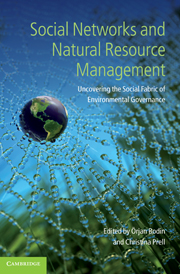 Social Networks and Natural Resource Management
Social Networks and Natural Resource Management from Part II - Case studies
Published online by Cambridge University Press: 05 June 2012
Introduction
There are numerous examples of successful natural resource management. Some of the more notable and well documented include mountain agriculture in the Swiss alps (Ostrom, 1990), irrigation systems in different parts of the world (Ostrom, 1990), Kristianstad Water Kingdom in Sweden (Olsson et al., 2004b; Schultz, 2009), and the Maine lobster fishery (Acheson, 1988). However, in many settings, governance for sustainable resource management remains an elusive goal and the current state of affairs is characterized by rigidity and inertia. This is sometimes a result of power struggles and elite capture (Barratt, 2009), but also because of lack of incentives and poor problem perception (Crona and Bodin, 2006; Bodin and Crona, 2008) or failure of top-down regulatory mechanisms (Ostrom, 1990). Transforming a system experiencing such inertia can be difficult and, among other things, requires appropriate leadership. The process of change has been likened to navigating turbulent rapids (Olsson et al., 2006) and the role of leadership has been hailed as one of the key factors in enabling transformation.
To save this book to your Kindle, first ensure [email protected] is added to your Approved Personal Document E-mail List under your Personal Document Settings on the Manage Your Content and Devices page of your Amazon account. Then enter the ‘name’ part of your Kindle email address below. Find out more about saving to your Kindle.
Note you can select to save to either the @free.kindle.com or @kindle.com variations. ‘@free.kindle.com’ emails are free but can only be saved to your device when it is connected to wi-fi. ‘@kindle.com’ emails can be delivered even when you are not connected to wi-fi, but note that service fees apply.
Find out more about the Kindle Personal Document Service.
To save content items to your account, please confirm that you agree to abide by our usage policies. If this is the first time you use this feature, you will be asked to authorise Cambridge Core to connect with your account. Find out more about saving content to Dropbox.
To save content items to your account, please confirm that you agree to abide by our usage policies. If this is the first time you use this feature, you will be asked to authorise Cambridge Core to connect with your account. Find out more about saving content to Google Drive.